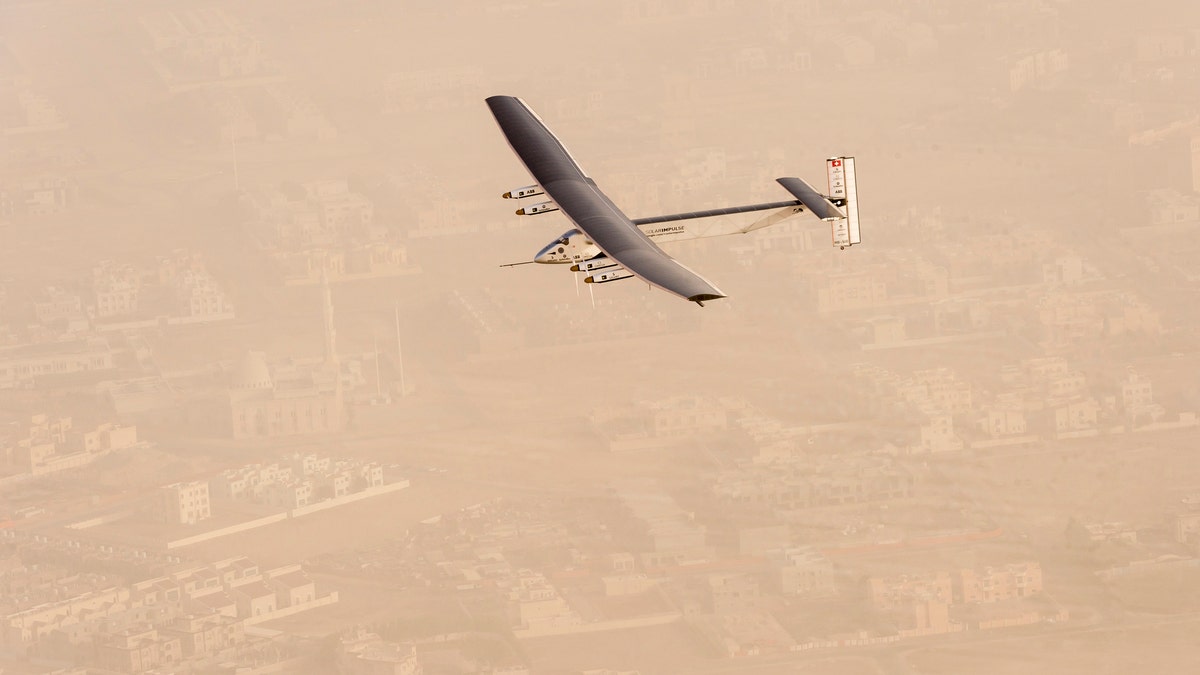
A view of the Solar Impulse 2 on flight after taking off from Al Bateen Airport in United Arab Emirates on March 9, 2015. (REUTERS/Jean Revillard/Handout via Reuters)
Solar Impulse 2 has embarked on the most daunting leg of its epic journey around the world. The single-seater solar-powered plane took off from Nanjing, China, Saturday, the start of a grueling 5,079-mile, five-day flight across the Pacific Ocean to Hawaii.
The latest leg of the journey, however, is the biggest challenge that the Solar Impulse 2 team has faced so far. While none of the previous legs were more than 20 hours, the estimated flight time to Hawaii, is 130 hours.
“I feel confident about this flight from Nanjing to Hawaii. It will be the flight of my life,” tweeted pilot Andre Borschberg shortly before takeoff at 2:39 p.m. ET.
The flight had been pushed back from Monday while the Solar Impulse 2 team waited for weather conditions to improve.
Solar Impulse 2, a larger version of a single-seat prototype that first flew five years ago, is made of carbon fiber and has 17,248 solar cells built into the wing that supply the plane with renewable energy, via four motors. The solar cells recharge four lithium polymer batteries, which provide power for night flying.
The plane has a 236-foot wingspan, larger than that of the Boeing 747, but, thanks to the lightweight carbon fiber, weighs about as much as a car at around 5,070 pounds.
The aircraft will climb to the altitude of Mount Everest, almost 29,500 feet, during the day to get more sunlight, recharge the batteries and store more energy. At nighttime, the plane will fly lower, at a minimum of 3,000 feet. Borschberg will experience temperatures ranging from 95 degrees Fahrenheit in the morning to minus 4 degrees Fahrenheit early in the evening while the plane is still high up.
Solar Impulse 2 is expected to fly between 30 mph and 60 mph during its journey.
Borschberg and his fellow Swiss pilot Bertrand Piccard are taking it in turns to fly the solar-powered aircraft on its five-month journey across the globe. Solar Impulse 2 set off from Abu Dhabi in March, and has stopped in Oman, India, and Myanmar en route to Nanjing.
After Hawaii, the second Pacific leg of the journey will take the plane to Phoenix. Solar Impulse 2 is slated to stop in New York before flying over the Atlantic Ocean. It will then stop in southern Europe or North Africa, depending on weather conditions.
“Good flight to Hawaii, @andreborschberg my solar brother ! Enjoy every moment of it !” tweeted Piccard on Saturday. “It will be experimental and unique,” he noted, in another tweet.
In addition to the technical challenges of flying the plane over a vast expanse of Pacific Ocean, Borschberg also will also face huge mental challenges.
“I have prepared a lot of things – I have done a lot of simulations,” he told FoxNews.com in a phone interview from Nanjing, China, earlier this month. “I have spent three days and three nights in a simulator – it’s the same physical environment, but it’s not the same emotional environment.”
The flight also presents physical challenges. Solar Impulse 2’s cockpit is too small to stand in, although the seat can recline into a horizontal position to allow Borschberg to lie down. “I will use meditation and breathing techniques to calm down and sleep,” he said, adding that he plans to sleep for 20 minutes at a time, up to eight times a day. “20 minutes is the maximum I can allow myself, to allow the airplane to fly by itself – we have a sort of autopilot – it’s a stabilization system.”
Piccard will fly the second Pacific leg, from Hawaii to Phoenix, a journey of 3,106 miles, which is expected to take between three and four days. “To see the coast of the U.S. after passing the second leg of the Pacific, it will be fantastic,” he told FoxNews.com, during a phone interview from Nanjing earlier this month.
The Associated Press contributed to this report.
Follow James Rogers on Twitter @jamesjrogers
